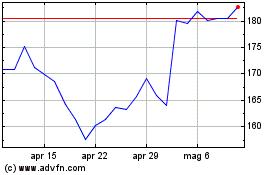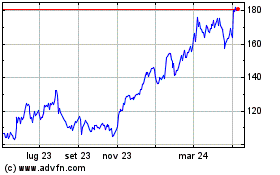I'm Sorry': Qualcomm and NXP Chiefs Lament Failed Deal via Texts -- Update
26 Luglio 2018 - 7:09PM
Dow Jones News
By Stu Woo
NXP Semiconductors NV Chief Executive Rick Clemmer got the text
message at 8:30 p.m. Wednesday. It was Qualcomm Inc. CEO Steve
Mollenkopf, thanking him for working together even though the chip
maker was about to abandon its nearly two-year-old, $44 billion bid
to buy NXP.
Mr. Clemmer didn't respond until 12:01 a.m. He had a smidgen of
hope that Chinese regulators would approve the merger by the
midnight Eastern time deadline Qualcomm had set.
The green light never came. Now Mr. Clemmer must plot a new
future for NXP, a Dutch business that makes computer chips for
automobiles, as a stand-alone company.
"We were prepared for this," Mr. Clemmer said in an interview
Thursday. "We were very confident about the transaction closing
until a few months ago. We realized it was a flip of a coin."
The companies announced their deal in October 2016, but it
became entangled in the U.S.-China trade feud. NXP's consolation
was a $2 billion breakup fee, which it had received by Thursday
morning.
It will use the funds quickly. To ease investor anxiety, NXP on
Thursday announced a $5 billion share buyback.
The most immediate challenge, though, could be to assure
shareholders that NXP has a plan on what it does next. Mr. Clemmer
said NXP missed out on potential business opportunities during the
21-month limbo, and analysts worry whether the company's senior
management is engaged.
Mr. Clemmer exercised options and sold more than $400 million of
NXP shares last autumn when they were trading around $113. On
Thursday, the stock traded around $91. NXP Chief Financial Officer
Daniel Durn left a year ago for the same role at rival
semiconductor maker Applied Materials Inc. NXP brought back a
previous CFO as a replacement.
"You worry about losing the good people," said Stacy Rasgon, an
analyst at Bernstein, adding that NXP "likely needs a new senior
management team."
In a conference call with analysts Thursday, Mr. Clemmer said he
and his team were fully engaged. He said NXP has plenty of room to
grow, but didn't answer some specific questions. "You have to give
us time," he said. His most definitive pronouncement was that NXP
would focus on its business. "I don't think you'll see us try to do
any big merger," he said.
NXP must also confront the reality that the markets it competes
in are changing. Based in a leafy office park in the small city of
Eindhoven in the Netherlands, NXP is a leading maker of chips used
in cars, especially for infotainment systems and sensors.
It also makes chips for identification and public-transit cards.
On Thursday, NXP reported a 10% rise in second-quarter profit to
$54 million, compared with the same period last year, on revenue up
1% at $2.3 billion.
However, competition to supply the automotive sector with chips
is increasing. Intel Corp. last year agreed to buy Israel's
Mobileye NV to boost its expertise in self-driving vehicles, while
Samsung Electronics Co. in late 2016 agreed to buy U.S. automotive
technology provider Harman International Industries Inc.
NXP could find itself marginalized. "A lot of what they sell are
things like sensors and peripherals and infotainment-type stuff,
but in the long run, the premise is the car will become more and
more like a computer, and NXP doesn't that have expertise today,"
said Tore Svanberg, a Stifel Nicolaus analyst. He said Qualcomm has
that know-how, but not the auto-industry relationships that NXP
has, which made the marriage attractive.
Mr. Clemmer told analysts Thursday that NXP could still partner
with Qualcomm.
Mr. Clemmer said he and his finance chief spent Wednesday at
NXP's Austin, Texas, office to be in the same time zone as many of
its investors. Mr. Clemmer received the text from Qualcomm's Mr.
Mollenkopf after the California-based company said in the late
afternoon that it planned to abandon the bid by midnight, barring
11th-hour Chinese approval.
In the evening, Mr. Clemmer said he spoke to the sales team in
Austin about how to keep customers who were excited about the
Qualcomm deal happy. Then shortly after midnight, when the deal was
officially abandoned, he responded to Mr. Mollenkopf.
"Many thanks for the kind words," he wrote. "I'm sorry that we
didn't have a chance to work together."
Write to Stu Woo at Stu.Woo@wsj.com
(END) Dow Jones Newswires
July 26, 2018 12:54 ET (16:54 GMT)
Copyright (c) 2018 Dow Jones & Company, Inc.
Grafico Azioni QUALCOMM (NASDAQ:QCOM)
Storico
Da Mar 2024 a Apr 2024

Grafico Azioni QUALCOMM (NASDAQ:QCOM)
Storico
Da Apr 2023 a Apr 2024
